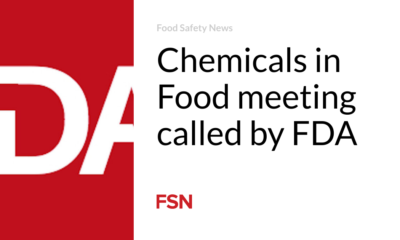Health
Exposure to common chemicals in early life permanently disrupts the gut microbiome, mouse study shows

Credit: Unsplash/CC0 public domain
Early life exposure to environmental ‘forever chemicals’ permanently disrupts the gut microbiome of mice, contributing to the development of metabolic diseases later in life, new research led by Penn State shows.
The results, published August 14 in the magazine Environmental health perspectivessuggest that human exposure to these chemicals during early childhood may contribute to the recent epidemic of metabolic disorders, including obesity and type 2 diabetes, among adults.
The researchers focused specifically on 2,3,7,8-tetrachlorodibenzofuran (TCDF), a widespread persistent organic pollutant (POP) that is a byproduct of waste incineration, metal production, and fossil fuel and wood combustion.
TCDF accumulates in the food chain and people are mainly exposed through the consumption of high-fat foods, such as meat, dairy products and some fish. Babies can be exposed through the consumption of breast milk.
“POPs are ubiquitous in the environment and almost every living organism has been exposed,” said Andrew Patterson, John T. and Paige S. Smith Professor of Molecular Toxicology and Biochemistry and Molecular Biology, Penn State.
“The negative health effects of these chemicals are well documented and include birth defects and cancer. Our study is the first to suggest that exposure to a particular POP called TCDF in early life also disrupts the gut microbiome and is later associated with metabolic disorders. in life.”
The team examined the effects of TCDF in two groups of mice: a test group, or those treated with TCDF, and a control group, or those who received no treatment. The team fed four-week-old mice for five days with pills containing either 0.46 micrograms (μg) of TCDF or a control pill that contained no TCDF. Although 0.46 µg is higher than what is typically found in human diets, it is not high enough to cause toxic diseases.
“In our study we used a dose that is relatively high compared to typical human exposure; however, we can use this information to identify new toxicity highlights, including in the gut microbiome, and extrapolate what might happen at even lower doses Of course, we also need to consider how complex mixtures of these POPs interact with us and our microbial partners, because a single exposure does not perfectly mimic real-life scenarios.”
The researchers then examined the animals’ gut microbiomes, along with several indicators of the animals’ health, including body weight, glucose tolerance, and the amounts of triglycerides in their liver and mucus in their feces, among other markers of metabolic diseases.
They collected this data immediately after the five-day course of TCDF, but also three months after the last dose. In humans, these times are the same as those of a baby and a young adult.
“We found that early life exposure to TCDF permanently disrupted the gut microbiomes of the wild-type mice,” said Yuan Tian, lead author and associate professor at Penn State. “We also found that these mice had higher body weight and glucose intolerance at four months of age.”
To further investigate the effects of TCDF on the gut microbiome, the scientists gave mice without a microbiome gut microbiome transplants from the mice with TCDF-disrupted microbiomes and measured their health outcomes. They found that the mice with the transplants developed metabolic disorders, suggesting that the altered microbiome is the cause of the metabolic disease.
“These results suggest that TCDF exposure in early life may cause the disruptions in gut microbiome function and health outcomes later in life, even long after the TCDF has been eliminated from the body,” Tian said.
She explained that the disruptions to the gut microbiome were characterized by a decrease in certain bacterial species, including Akkermansia muciniphila, a bacterium also typically found in the human gut microbiome.
“This is important because Akkermansia is recognized as important for overall gut health, but now we know it can be negatively affected by TCDF,” Tian said.
To investigate the importance of Akkermansia muciniphila in influencing health outcomes, the team experimented with administering the bacteria as a probiotic to TCDF-treated mice. The probiotic restored the microbiome to its normal state.
“Our findings suggest that these bacteria are affected by toxic exposure and play an important role in mediating health outcomes,” said Patterson.
“It is possible that with more research we may one day be able to restore a person’s microbiome to its optimal state through supplementation with pre- and probiotics.”
More information:
Yuan Tian et al., Effects of early life exposure to the aryl hydrocarbon receptor ligand TCDF on gut microbiota and host metabolic homeostasis in C57BL/6J mice, Environmental health perspectives (2024). DOI: 10.1289/EHP13356
Quote: Early life exposure to common chemicals permanently disrupts the gut microbiome, shows mouse study (2024, August 14), retrieved August 15, 2024 from https://medicalxpress.com/news/2024-08-early-life- exposure-common-chemical. html
This document is copyrighted. Except for fair dealing purposes for the purpose of private study or research, no part may be reproduced without written permission. The content is provided for informational purposes only.













